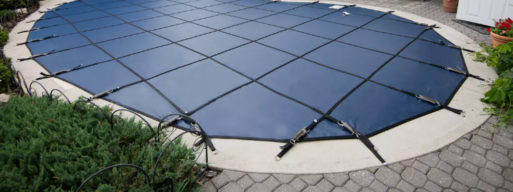How to Close a Swimming Pool for the Winter
With winter approaching, pool owners sadly need to close down their pool and say goodbye until the spring. However, you can’t just simply stop using your pool and wait for winter to end. Closing your pool for winter requires multiple vital steps to protect your pool from damage that can occur during wintertime. This process is called “winterization.”
Keep reading to learn the best time to close your pool, and how you can ensure that your pool is in top condition when it becomes usable again.
When to Close Your Pool For Winter
Many pool-owners keep their pool open in the fall in case a late rush of hot weather hits. But when is the correct time to officially close up for the winter? Most Ontario pool-owners have everything closed up on or before Thanksgiving, however, the rule of thumb is that you should be finished closing your pool before the weather hits 0 degrees Celsius.
Why Proper Winterization Is Needed
Winterization involves cleaning a pool, balancing its chemicals, and preparing it to endure the oncoming harsh weather conditions. These steps are necessary for proper pool care. Otherwise, your pool can endure damage or become contaminated. Plus, skipping this process will give you extra work to tackle in the spring.
Read More: Salt Water Pool Winter Care
Steps to Properly Close Your Pool
Clean Your Pool
The first step of winterization is to give your pool a good cleaning. This includes vacuuming all surfaces, brushing walls, and removing any waste. Thorough cleaning will make the following steps easier.
Balance Your Pool Water
It is vital to make sure that your pool’s chemical balances are leveled. You may choose to do this with testing strips or a testing kit. Ideally, your pool should have a pH level at or around 7.4. Meanwhile, chlorine should be levelled at 1 to 3 parts per million during the winter. If these levels are not accurate, simply add the necessary chemicals until they are fixed. Pool care providers can test your water if you are not certain that it is balanced properly.
Treat Any Water Issues
If your water needs any further treatment whatsoever, speak to a pool care provider before continuing with the following steps.
Add Closing Chemicals
After your pool’s pH, alkaline, and calcium levels are balanced, you’ll want to add closing chemicals to your pool. These chemicals offer necessary protection to your pool during harsh, cold weather and can be purchased individually or bundled into kits.
Popular winter closing chemicals include:
- Algaecide – This chemical fights algae buildup for the entire winter season.
- Pool Enzymes – These chemicals help eliminate organisms that may contaminate your pool water.
- WinterPill – This chemical sanitizer dissolves and clarifies water in order to keep it clean over the winter months.
Add Stain and Scale Preventer
Now it’s time to add a product that takes care of damage from staining and scaling. Stains naturally build up in pools over time. Scaling, meanwhile, occurs when calcium deposits are left on a pool’s surface — this can create a white line around the pool. These can be prevented with the right products.
Clean Your Sand Filter
Your sand filter system should be properly cleaned and stored over the winter. Many sand filters have a “winterize” setting to simplify this process. You will need to drain all water from your sand filter’s tank, and disconnect all hoses from the filter. Then, store the sand filter in a cool, dry place until it is ready to be used again.
Add Anti-Freeze to Pool Equipment
Prevent your pool’s pipes from freezing by applying anti-freeze. Frozen water can crack your pool’s pipes and damage many of its components. Under no circumstances should you pour antifreeze directly into your pool.
Put On Your Safety Cover
Once all necessary chemicals have been added, and equipment has been properly stored, you can finally put the pool’s safety cover over the pool. Make sure the cover is attached to the pool properly to prevent debris from falling in.
Read More: The Importance of Pool Safety Covers
Keep An Eye Out For Issues Throughout The Winter
Check on your pool’s cover occasionally. Watch out for issues such as tears, debris or water buildup on the cover. You may need to gently use a rake to get debris off the cover, or use a pool pump to keep the cover clean.
Read More: Hot Tub Winter Closing Guide
Winterizing your pool may seem like a hassle, but it will be worth it. By taking the appropriate steps and completing them correctly, your pool will be safe, clean, and ready to cool you off once the snow melts and warm, sunny weather returns.


